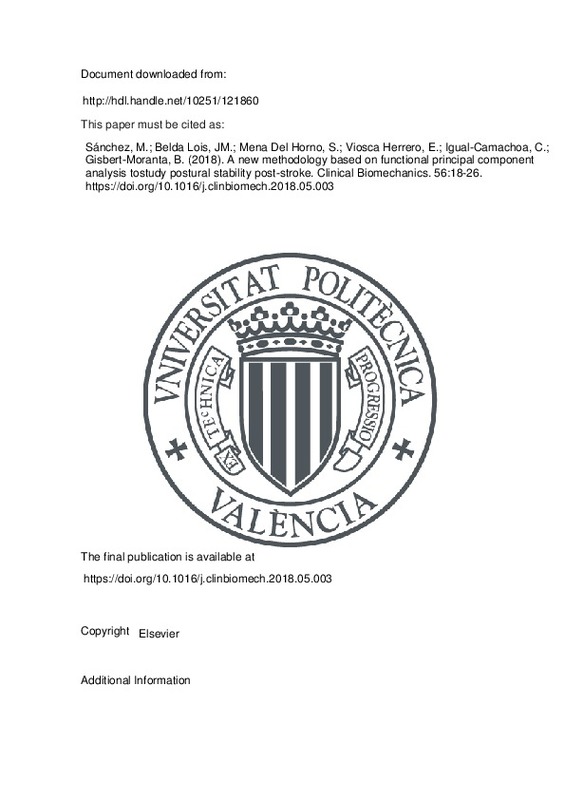JavaScript is disabled for your browser. Some features of this site may not work without it.
Buscar en RiuNet
Listar
Mi cuenta
Estadísticas
Ayuda RiuNet
Admin. UPV
A new methodology based on functional principal component analysis tostudy postural stability post-stroke
Mostrar el registro sencillo del ítem
Ficheros en el ítem
| dc.contributor.author | Sánchez, M.L.
|
es_ES |
| dc.contributor.author | Belda Lois, Juan Manuel
|
es_ES |
| dc.contributor.author | Mena Del Horno, Silvia
|
es_ES |
| dc.contributor.author | Viosca Herrero, Enrique
|
es_ES |
| dc.contributor.author | Igual-Camachoa, C.
|
es_ES |
| dc.contributor.author | Gisbert-Moranta, B.
|
es_ES |
| dc.date.accessioned | 2019-06-09T20:25:43Z | |
| dc.date.available | 2019-06-09T20:25:43Z | |
| dc.date.issued | 2018 | es_ES |
| dc.identifier.issn | 0268-0033 | es_ES |
| dc.identifier.uri | http://hdl.handle.net/10251/121860 | |
| dc.description.abstract | [EN] Background. A major goal in stroke rehabilitation is the establishment of more effective physical therapy techniques to recover postural stability. Functional Principal Component Analysis provides greater insight into recovery trends. However, when missing values exist, obtaining functional data presents some difficulties. The purpose of this study was to reveal an alternative technique for obtaining the Functional Principal Components without requiring the conversion to functional data beforehand and to investigate this methodology to determine the effect of specific physical therapy techniques in balance recovery trends in elderly subjects with hemiplegia post-stroke. Methods: A randomized controlled pilot trial was developed. Thirty inpatients post-stroke were included. Control and target groups were treated with the same conventional physical therapy protocol based on functional criteria, but specific techniques were added to the target group depending on the subjects' functional level. Postural stability during standing was quantified by posturography. The assessments were performed once a month from the moment the participants were able to stand up to six months post-stroke. Findings: The target group showed a significant improvement in postural control recovery trend six months after stroke that was not present in the control group. Some of the assessed parameters revealed significant differences between treatment groups (P < 0.05). Interpretation: The proposed methodology allows Functional Principal Component Analysis to be performed when data is scarce. Moreover, it allowed the dynamics of recovery of two different treatment groups to be determined, showing that the techniques added in the target group increased postural stability compared to the base protocol. | es_ES |
| dc.language | Inglés | es_ES |
| dc.publisher | Elsevier | es_ES |
| dc.relation.ispartof | Clinical Biomechanics | es_ES |
| dc.rights | Reconocimiento - No comercial - Sin obra derivada (by-nc-nd) | es_ES |
| dc.subject | Functional Principal Component Analysis | es_ES |
| dc.subject | Stroke | es_ES |
| dc.subject | Postural stability | es_ES |
| dc.subject | Posturography | es_ES |
| dc.subject | Romberg | es_ES |
| dc.subject.classification | INGENIERIA MECANICA | es_ES |
| dc.title | A new methodology based on functional principal component analysis tostudy postural stability post-stroke | es_ES |
| dc.type | Artículo | es_ES |
| dc.identifier.doi | 10.1016/j.clinbiomech.2018.05.003 | es_ES |
| dc.rights.accessRights | Abierto | es_ES |
| dc.date.embargoEndDate | 2019-07-01 | es_ES |
| dc.contributor.affiliation | Universitat Politècnica de València. Departamento de Ingeniería Mecánica y de Materiales - Departament d'Enginyeria Mecànica i de Materials | es_ES |
| dc.description.bibliographicCitation | Sánchez, M.; Belda Lois, JM.; Mena Del Horno, S.; Viosca Herrero, E.; Igual-Camachoa, C.; Gisbert-Moranta, B. (2018). A new methodology based on functional principal component analysis tostudy postural stability post-stroke. Clinical Biomechanics. 56:18-26. https://doi.org/10.1016/j.clinbiomech.2018.05.003 | es_ES |
| dc.description.accrualMethod | S | es_ES |
| dc.relation.publisherversion | https://doi.org/10.1016/j.clinbiomech.2018.05.003 | es_ES |
| dc.description.upvformatpinicio | 18 | es_ES |
| dc.description.upvformatpfin | 26 | es_ES |
| dc.type.version | info:eu-repo/semantics/publishedVersion | es_ES |
| dc.description.volume | 56 | es_ES |
| dc.identifier.pmid | 29775954 | |
| dc.relation.pasarela | S\384780 | es_ES |







![[Cerrado]](/themes/UPV/images/candado.png)

